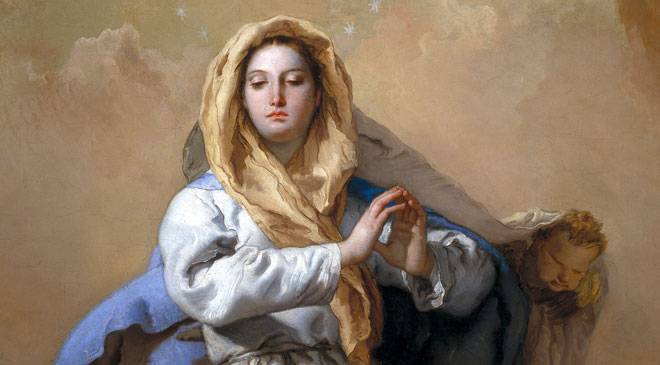By Lucas R. Pollice
Lucas Pollice is the director of Adult Catechesis and RCIA for the Diocese of Fort Worth, Texas. He has taught RCIA for over ten years and is a regular speaker at catechetical conferences. He is the author of Open Wide the Doors to Christ: Discovering Catholicism.

If you ask people, including many Catholics, about the Immaculate Conception, there is a great chance they will tell you that it is the conception of Jesus in the womb of Mary. The Immaculate Conception is actually the conception of Mary. The Immaculate Conception reveals to us that Mary was freed from the stain of original sin at the moment of her conception, and remained free from sin for her entire life.
It was intrinsic to God’s plan of salvation that Mary was created without original sin. Since Adam and Eve represented all of the human family when they fell away from God, all of humanity fell away with them. Original sin was passed on to their children and to their children’s children, all throughout human history. When we are conceived we are born into a natural separation from God called original sin and with an inclination toward sin.
God’s rescue plan was to have His only Son, the second Person of the Holy Trinity, assume a human nature so that as both God and man Jesus could accomplish the redemption of the human race. One problem arises: God is all-holy. Therefore, He is in complete and total opposition to sin. Sinners cannot even come into His presence without being purified. How then would God the Son be able to intimately join Himself with a fallen human nature? This is where God’s plan for Mary comes in. God chose her to be conceived without original sin so that she would be able to give Jesus a pure and sinless human nature. Mary is the pure and stainless vessel through which Jesus receives a sinless and immaculate human nature so that He can enter the world to complete the Father’s plan of salvation.
Let us go back to the Book of Genesis where God announced for the first time His plan of salvation that will be accomplished through Christ: "I will put enmity between you and the woman, and between your offspring and hers; He will strike at your head, while you strike at his heel." (Gen 3:15)
It is important that we identify exactly who God is addressing and talking about. God is speaking to the serpent, and He says that the offspring of the woman will strike at his head. Who is the one who will strike at the head of the serpent? Jesus is the one who will come, strike at Satan’s head, and destroy his power. So if the offspring of the woman is Jesus, then the woman must be Mary.
God speaks of enmity between the serpent and the woman, and between the serpent’s offspring and the woman’s offspring. The offspring of Satan is sin, with which Satan desires to multiply and fill the earth. Therefore, there is enmity between Mary/Jesus and Satan/sin. Enmity means total and complete opposition. If two things are in enmity with each other, they have nothing at all to do with one another; there is absolutely no cooperation or communion between the two. Consequently, both Jesus and Mary are completely opposed to Satan and sin. They would have absolutely no cooperation or communion with Satan and sin.
It was necessary that Mary not have a fallen nature since any participation in original sin or actual sin would destroy the enmity with Satan and sin. Thus, we see in the very first announcement of God’s plan of salvation His intention to keep Mary totally free from sin so that Jesus would be able to assume a pure human nature.
We see an even more explicit reference to the Immaculate Conception of Mary in Luke’s Gospel at the Annunciation. The angel Gabriel appears to Mary to announce God’s plan for her to be the mother of Jesus. The angel Gabriel’s greeting to Mary reveals her immaculate state. His greeting properly translated is “Hail, you who have been filled with grace.” (Luke 1:28) The Greek word kekaritomene is a perfect participle, “have been filled.” Mary has already been filled with God’s grace, for grace has already been infused into her at the moment of her conception.
The angel’s greeting reveals another truth about Mary. Anytime someone sins, even the smallest sin, the person loses at least some of God’s grace. That is the nature of sin: a choice a person makes that rejects the grace He offers to us, which is His very life and love. If Mary is filled with grace, then she would have been completely free from sin, because any sin, even the tiniest, would have caused her to be deprived of at least some grace.
How exactly did God preserve Mary from original sin? In his papal bull on the Immaculate Conception, Pope Pius IX stated that she was preserved from sin “by a singular grace and privilege of the Omnipotent God, in view of the merits of Jesus Christ.”
Mary needed Christ to redeem her just as much as we all do. She was redeemed by her Son’s death on the Cross just like all of us. But how could Mary have been redeemed by Jesus’ death on the Cross before Jesus was even born?
God is eternal and transcendent, and therefore He is not bound by either space or time. He sees all of time—past, present, and future—at once. It is like looking at a very long train from a helicopter. The engines are creation, the caboose the end of the world, and we are somewhere in between the two. God operates outside of time. Therefore, He took the graces and merits of Jesus’ death on the Cross and applied them backwards in time to the moment of Mary’s conception. Mary was redeemed by Christ as we all are, but through a “singular (special) grace and privilege of the Omnipotent God” she was also completely preserved from original sin. The important distinction, however, is that Mary was redeemed but also preserved from sin. She never had sin, even for a second. From the very moment of her existence, Mary was completely preserved from sin and thus never knew or cooperated with sin her entire life.
Even though Mary was preserved from original sin at the moment of her conception, she could have still chosen to sin since she had free will. She could have still rejected God’s grace and His plan and fallen into sin. She could have said no to the Father at the Annunciation. She could have said no to the Father at the foot of the Cross where she surrendered her Son. She could have fallen into despair and cursed God. Rather, Mary perfectly cooperated and surrendered herself to the great gift of grace that God had given her and lived the most extraordinary Christian life. This is why Mary is the model of faith and the model of the Church. We are all called to cooperate with whatever graces God chooses to give us so that we humbly and lovingly walk whatever path He wills for us.
You Might Also Like

Learn more about Mary’s central role in salvation history in The Bible and the Virgin Mary. In twelve video lessons, a Participant Workbook, Leader Guide, and supplemental resources, you'll discover the biblical basis for the Church's teachings on Mary.

